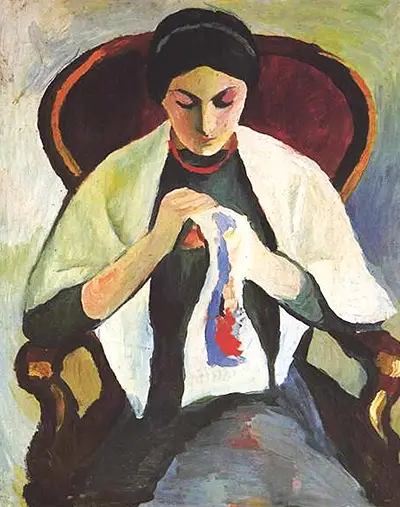 Buy Art Prints Now
Buy Art Prints Nowfrom Amazon
* As an Amazon Associate, and partner with Google Adsense and Ezoic, I earn from qualifying purchases.
Macke produced a number of portraits of women sewing during a period in which he focused on the domestic lives of the opposite sex. There was another from 1909 titled Elisabeth Gerhardt Sewing, suggesting the name of the model featured here.
The model sits on a classically-styled chair whilst draped in a white shawl which can be seen in a number of other Macke paintings. She looks completely focused on her hobby, enjoying perhaps a rare moment of peace as she tries to develop a small piece of embroidery. It is almost a historic diary of life in Germany during the early 20th century, but sadly this tranquility was soon to be replaced by the horrors of the "Great War", which also ultimately took the artist's own life. The woman's arms in this painting are angled similar to someone preying or in meditation, which again communicates a positive atmosphere of pure calm. Indeed, this hobby is sometimes recommended as a means to battling certain mental health issues, due to the impact it can have on distracting one from other concerns.
In line with the majority of his other paintings, Macke left out most detail in his portrait here - the hands are distinctly undeveloped. This was part of the process that the artist was going through towards greater abstraction which would go much further than this by the point of his death just a few years later. One addition to this portrait that is missing from the woman's attire elsewhere is a small red necklace.
Those knowledgeable about the career of August Macke will immediately spot similarities between Woman Sewing as well as another artwork from 1909 - namely Woman Reading. This was a period in the artist's career where he produced a number of domestic scenes, when most of the rest of his career was devoted to portraits based outdoors, such as in gardens or forests. He also went on to create a number of landscape paintings as well. The model herself is probably also featured in Portrait with Apples, though information on her is spare, of all that has been translated into English. It is likely that more information on her is available in some of the domestically-produced publications in 20th century Germany, where his career retains the greatest focus.




